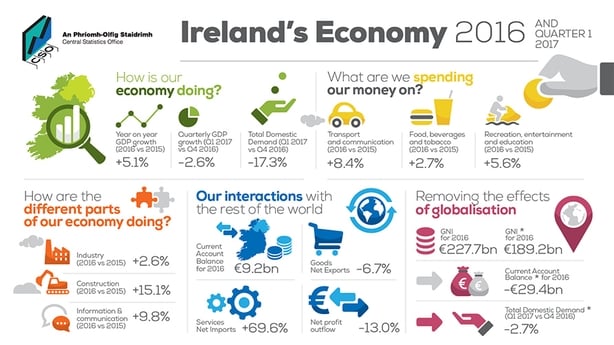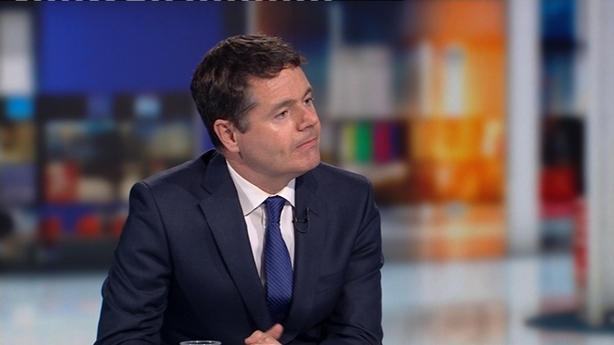The economy - as measured by GDP - grew by 5.1% in 2016, the latest figures from the Central Statistics Office show.
This confirms that Ireland was the fastest growing economy in the European Union last year.
At current prices, GDP (Gross Domestic Product) in 2016 was €275.6 billion, the CSO figures show.
Using a new measure of the size of the economy that removes much of the volatility in Irish national accounts due to the activities of multinational companies, aircraft leasing and intellectual property accounting, the size of the Irish economy was €189.2 billion.
This is measured under a modified version of Gross National Income, known as GNI*.
The new measure is supplementary to GDP, which remains the official measure of the economy for international reporting.
The new GNI* measure is intended to give a more accurate picture of the underlying state of the Irish economy, when the large movements of intellectual property and aircraft leasing are filtered out.
Using this new modified indicator, the economy grew by 9.4% last year.
Real economy performing well despite drop in Q1 GDP pic.twitter.com/bPZnCk8AYw
— RTÉ Business (@RTEbusiness) July 14, 2017
Using GNI* as a measure substantially changes the measures used to compare the Irish economy with other countries.
This is most clearly seen in the debt ratio. Measured as a percentage of GDP, the government's debt ratio is 73%. But measured against modified GNI, it shows a debt ratio of 105%.
Going back over the past few years, the modified measures shows government debt peaking at almost 160%, compared to a debt to GDP ratio of 120%.
While the debt ratio has fallen over the past five years, the GNI* figure indicates a much higher level of debt.
It also increases the relative size of the budget deficit. In 2016 it was 0.7% of GDP, but using GNI* the deficit was 1%. In 2012 the deficit was 8% of GDP, but 10.5% of GNI*.
A range of other key metrics covering taxation and spending will also change as a result of the new measure, which will supplement, but not supplant GDP in official reporting.

Meanwhile, today's figures from the Central Statistics show that the economy slowed by 2.6% on a GDP basis in the first quarter of this year.
Preliminary National Accounts figures from the CSO for the first three months of the year show a decrease of 2.6% in GDP and a decrease of 7.1% in GNP.
The fall in GDP was due to volatile movements in the aircraft leasing industry and Intellectual Property movements in the information technology sector.
But the country's GDP still stood 6.1% higher than the same time last year after data for the previous quarter was revised up sharply to 5.8% from 2.5%.
Growth for all of last year was nudged down to 5.1% from 5.2%, the CSO said.
GNP growth was revised up to 9.6% from 9%, while personal consumption of goods and services showed growth of 3.3%, previously estimated at 3%, for 2016.
"Today's results include preliminary estimates for key recommendations made by the expert group, including a modified indicator of the overall size or level of the economy (GNI*) and a modified total domestic demand indicator that focuses on activity within the Irish economy," commented the CSO's Assistant Director General with responsibility for Economic Statistics, Jennifer Banim.
"These modified indicators are designed to exclude significant globalisation effects that disproportionately affect the Irish economic results," Ms Banim said.
Finance Minister Paschal Donohoe said that today's data provide clear evidence of continued momentum in the economy this year with annual GDP growth of 6.1% recorded in the first quarter.

"These figures are mirrored in strong employment growth, as well as tax receipts to end-June which increased by 4% over the same period last year," the Minister said.
But Mr Donohoe said the still elevated levels of debt in the Irish economy and the increasingly uncertain external environment underlines the importance of sensible management of the public finances.
"That is what the Summer Economic Statement sets out and what the Government will continue to do," he added.
Separate figures from the CSO today, showed that the Balance of Payments results for the first quarter showed the current account recorded a surplus of €8.570 billion or 12.4% of GDP.
This was an increase of €1.238 billion on the surplus of €7.332 billion, or 11.3% of GDP, in the opening quarter of last year.

